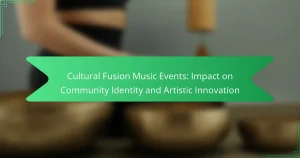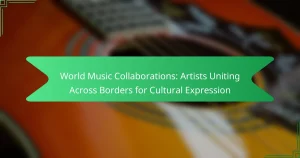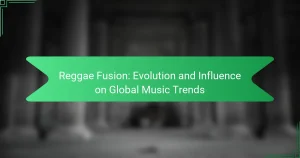Afrobeat artists are redefining music by blending traditional African rhythms with modern genres, creating a vibrant sound that resonates globally. This article explores the unique techniques used by prominent artists, the impact of collaborations, and the engagement with social and political themes. It also addresses the challenges faced in the global music industry and how social media and streaming platforms are crucial for their success. Finally, we look at the future trends shaping Afrobeat’s evolution and cultural significance.
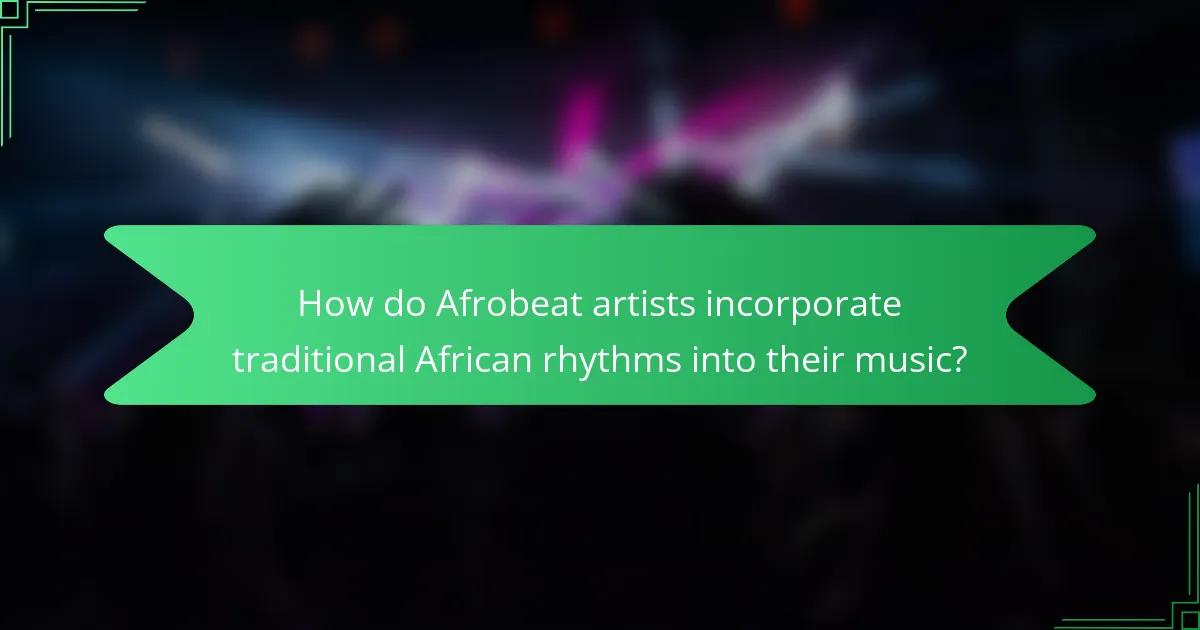
How do Afrobeat artists incorporate traditional African rhythms into their music?
Afrobeat artists blend traditional African rhythms into their music by integrating polyrhythmic patterns and indigenous instruments. This fusion creates a vibrant sound that reflects cultural heritage while appealing to modern audiences.
Prominent artists like Fela Kuti and Burna Boy utilise traditional drumming techniques, such as the use of the talking drum, which adds a unique layer to their compositions. The incorporation of call-and-response vocal styles further enhances the traditional elements, creating an interactive performance experience.
Additionally, Afrobeat artists often sample traditional songs, reinterpreting them within contemporary genres. This approach not only preserves the essence of African music but also introduces it to a global audience, fostering cultural appreciation and exchange.
Overall, the seamless integration of traditional rhythms allows Afrobeat to maintain its roots while evolving in the modern music landscape.
What are the key elements of traditional African rhythms used in Afrobeat?
Traditional African rhythms in Afrobeat emphasise polyrhythms, syncopation, and call-and-response patterns. These elements create a vibrant and dynamic sound that merges seamlessly with modern genres. Polyrhythms involve multiple contrasting rhythms played simultaneously, enhancing the complexity of the music. Syncopation adds unexpected accents, creating a lively feel. Call-and-response patterns engage listeners, fostering a communal atmosphere. Together, these key elements form the foundation of Afrobeat, showcasing its roots in traditional African music while embracing contemporary influences.
How do Afrobeat artists blend these rhythms with modern genres?
Afrobeat artists blend traditional African rhythms with modern genres by incorporating electronic elements, hip-hop beats, and jazz improvisation. This fusion creates a vibrant sound that appeals to diverse audiences. Artists like Burna Boy and Wizkid exemplify this blend, using Afrobeat as a foundation while experimenting with R&B and dancehall influences. The result is a unique sound that retains cultural roots while embracing contemporary trends.
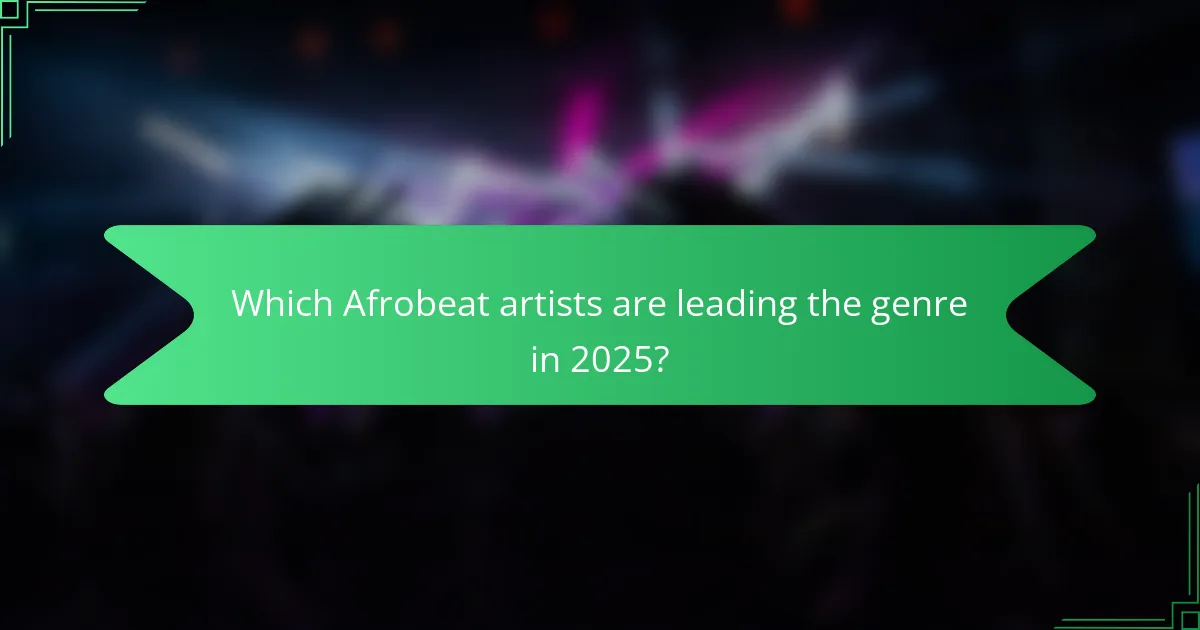
Which Afrobeat artists are leading the genre in 2025?
In 2025, leading Afrobeat artists include Burna Boy, Wizkid, Tems, and Davido. These artists blend traditional African rhythms with contemporary sounds, pushing the genre’s global influence. Burna Boy continues to dominate with his unique fusion of Afrobeat and dancehall. Wizkid’s collaborations and innovative production keep him at the forefront. Tems, recognised for her powerful vocals, brings a fresh perspective, while Davido’s energetic performances resonate widely. Their contributions showcase Afrobeat’s evolution and growing popularity worldwide.
What unique styles do prominent Afrobeat artists bring to their music?
Prominent Afrobeat artists bring unique styles by incorporating diverse influences and innovative rhythms. For instance, Fela Kuti’s fusion of traditional African music with jazz and funk established a distinct sound. Burna Boy blends Afrobeat with dancehall and reggae, creating a global appeal. Wizkid combines Afrobeats with R&B and pop, enhancing mainstream accessibility. Tiwa Savage infuses elements of hip-hop and soul, showcasing versatility. Each artist’s unique attribute lies in their ability to merge various genres while retaining African cultural roots.
How has the popularity of Afrobeat artists evolved in different regions?
The popularity of Afrobeat artists has surged globally, with significant growth in regions like Africa, Europe, and North America. Afrobeat blends traditional African rhythms with modern genres, attracting diverse audiences. In Africa, artists like Burna Boy and Wizkid have gained mainstream success, reflecting cultural pride and contemporary influences. Europe has embraced Afrobeat through festivals and collaborations, while North America sees Afrobeat’s integration into pop music. This evolution highlights Afrobeat’s unique ability to resonate across different cultures, driving its global appeal.
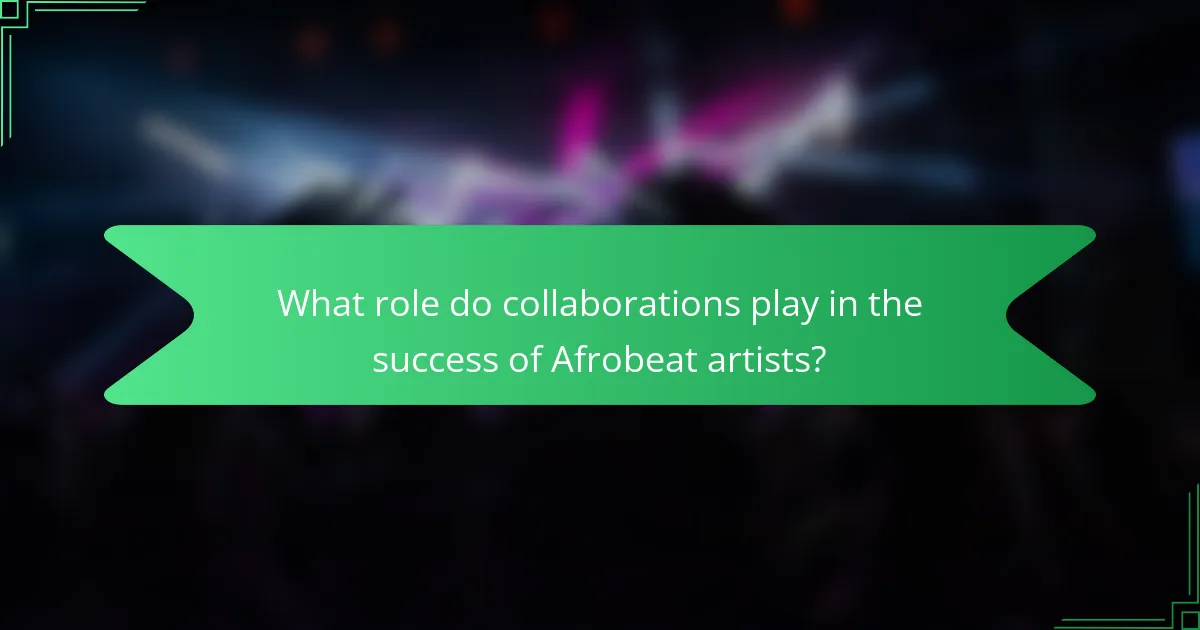
What role do collaborations play in the success of Afrobeat artists?
Collaborations significantly enhance the success of Afrobeat artists by expanding their audience reach and blending diverse musical influences. These partnerships allow artists to integrate traditional African rhythms with modern genres, creating unique sounds that resonate globally. Collaborations can lead to increased visibility through cross-promotion, attracting fans from different musical backgrounds. Additionally, they foster creativity, enabling artists to experiment and innovate, which can result in chart-topping hits. Collaborations often leverage the unique attributes of each artist, enriching the Afrobeat genre and contributing to its growing popularity worldwide.
How do Afrobeat artists collaborate with artists from other genres?
Afrobeat artists frequently collaborate with musicians from various genres to create innovative sounds. These collaborations often blend traditional African rhythms with elements from hip-hop, R&B, and electronic music. This fusion enhances the appeal of Afrobeat, attracting diverse audiences and expanding its global reach. Notable examples include Burna Boy’s work with Ed Sheeran and Wizkid’s collaboration with Drake, showcasing the genre’s versatility. Such partnerships not only introduce Afrobeat to new listeners but also enrich the musical landscape by merging distinct cultural influences.
What are some notable collaborations that have shaped the genre?
Collaborations between Afrobeat artists and musicians from various genres have significantly shaped the genre. Notable partnerships include Burna Boy and Beyoncé on “Ja Ara E,” which fused Afrobeat with pop elements. Wizkid’s collaboration with Drake on “One Dance” showcased the global appeal of Afrobeat, blending hip-hop with traditional rhythms. Another key collaboration is Fela Kuti’s influence on artists like Questlove, merging Afrobeat with jazz and funk. These partnerships highlight the genre’s versatility and its ability to evolve through cross-genre experimentation.
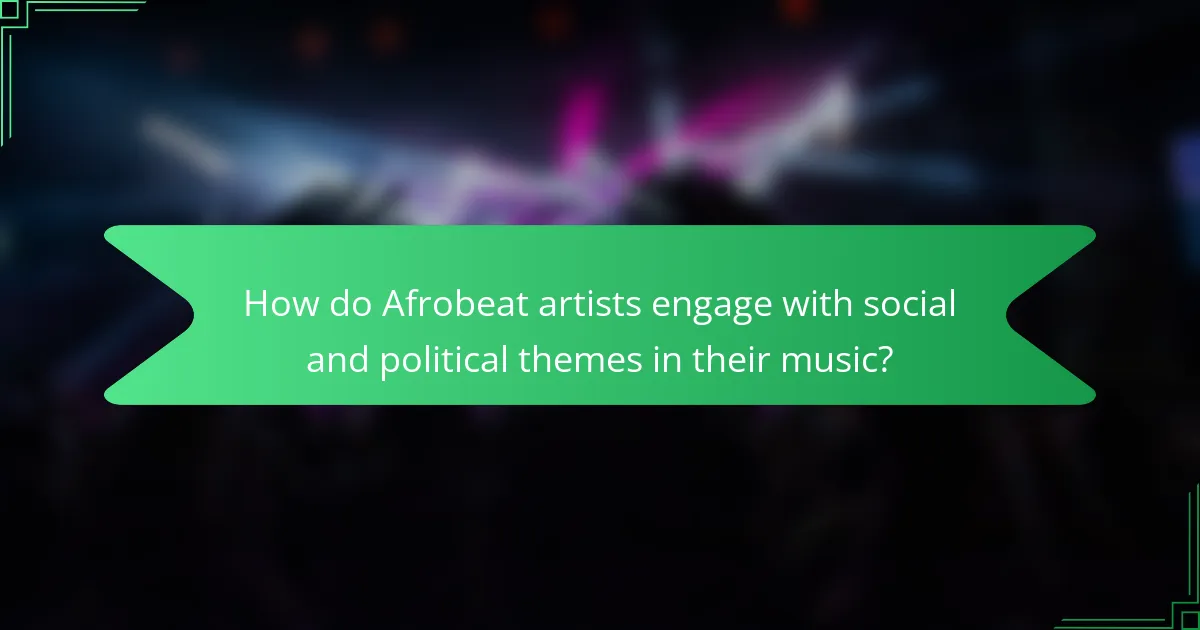
How do Afrobeat artists engage with social and political themes in their music?
Afrobeat artists engage with social and political themes by using music as a platform for activism. They address issues like corruption, inequality, and human rights, resonating deeply with listeners. For example, Fela Kuti’s work critiqued Nigerian governance, blending traditional African rhythms with modern styles to amplify his message. This unique attribute of Afrobeat allows for a powerful cultural commentary, making it relevant in today’s socio-political landscape. Artists like Burna Boy and Wizkid continue this legacy, using their global reach to highlight pressing issues in Africa and beyond.
What messages are commonly conveyed in Afrobeat lyrics?
Afrobeat lyrics commonly convey messages of social justice, cultural pride, and political awareness. They often address issues like inequality, corruption, and identity, reflecting the experiences and struggles of African communities. Many artists blend traditional African storytelling with contemporary themes, creating a rich tapestry of meaning. For example, Fela Kuti, a pioneer of Afrobeat, used his music to critique government oppression and advocate for human rights. This unique attribute of combining activism with art distinguishes Afrobeat within the global music landscape.
How do these themes resonate with audiences across cultures?
Afrobeat themes resonate with audiences globally by blending traditional African rhythms with contemporary styles. This fusion creates a universal appeal, allowing diverse cultures to connect through music. The infectious beats and vibrant energy of Afrobeat transcend language barriers, fostering a sense of community among listeners. For instance, artists like Burna Boy and Wizkid incorporate elements from hip-hop and R&B, attracting fans from various backgrounds. The unique attribute of Afrobeat lies in its ability to celebrate African heritage while embracing modern influences, making it relevant across different cultural contexts.
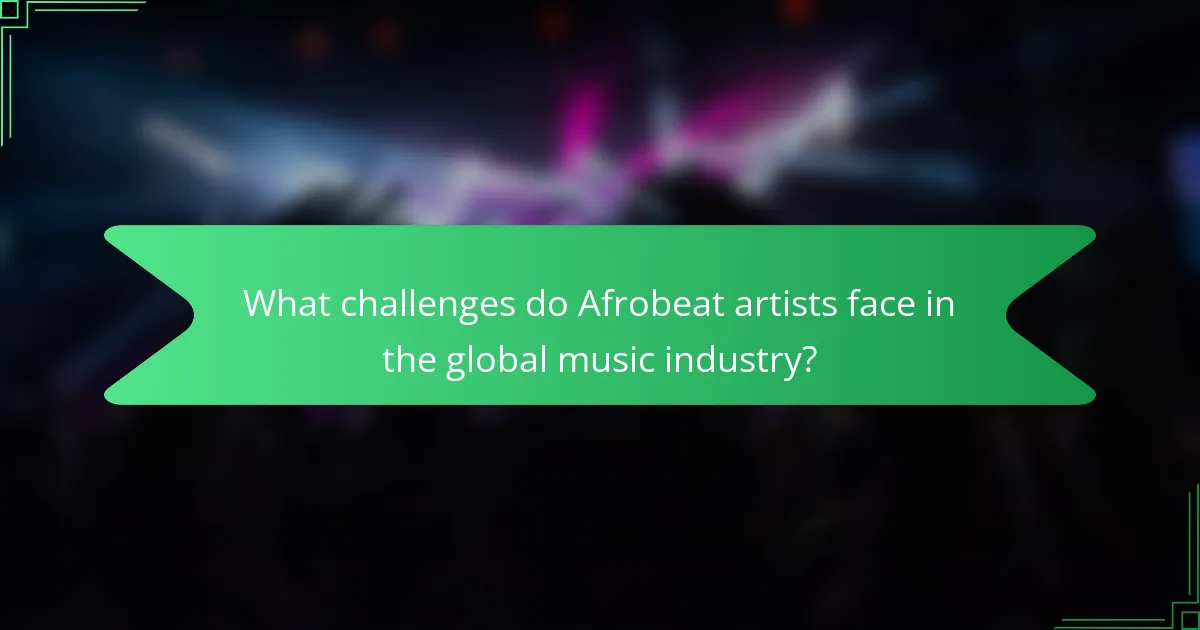
What challenges do Afrobeat artists face in the global music industry?
Afrobeat artists face numerous challenges in the global music industry, including cultural misrepresentation, limited access to international markets, and competition with established genres. They often struggle to gain mainstream recognition despite their unique sound. Additionally, financial constraints hinder their ability to produce high-quality music and promote their work effectively. The lack of industry support and resources further complicates their journey, making it difficult to navigate the complexities of a global audience.
How do Afrobeat artists navigate cultural appropriation and authenticity?
Afrobeat artists navigate cultural appropriation and authenticity by blending traditional African rhythms with modern genres while respecting their roots. They often collaborate with local musicians to maintain authenticity and showcase cultural narratives. This approach fosters a genuine connection to heritage, making their music relatable globally. Additionally, artists engage in discussions about cultural identity, emphasizing the importance of understanding the origins of the sounds they incorporate. This dialogue helps combat appropriation and promotes appreciation of Afrobeat’s rich history.
What are the common barriers to international success for Afrobeat artists?
Afrobeat artists face several common barriers to international success. Limited global exposure hinders their ability to reach wider audiences. Cultural differences can affect the acceptance of their music in various markets. Additionally, inadequate marketing resources restrict their promotional efforts. Language barriers may also prevent effective communication with international fans and industry stakeholders. Lastly, competition from established genres complicates their entry into mainstream music markets.
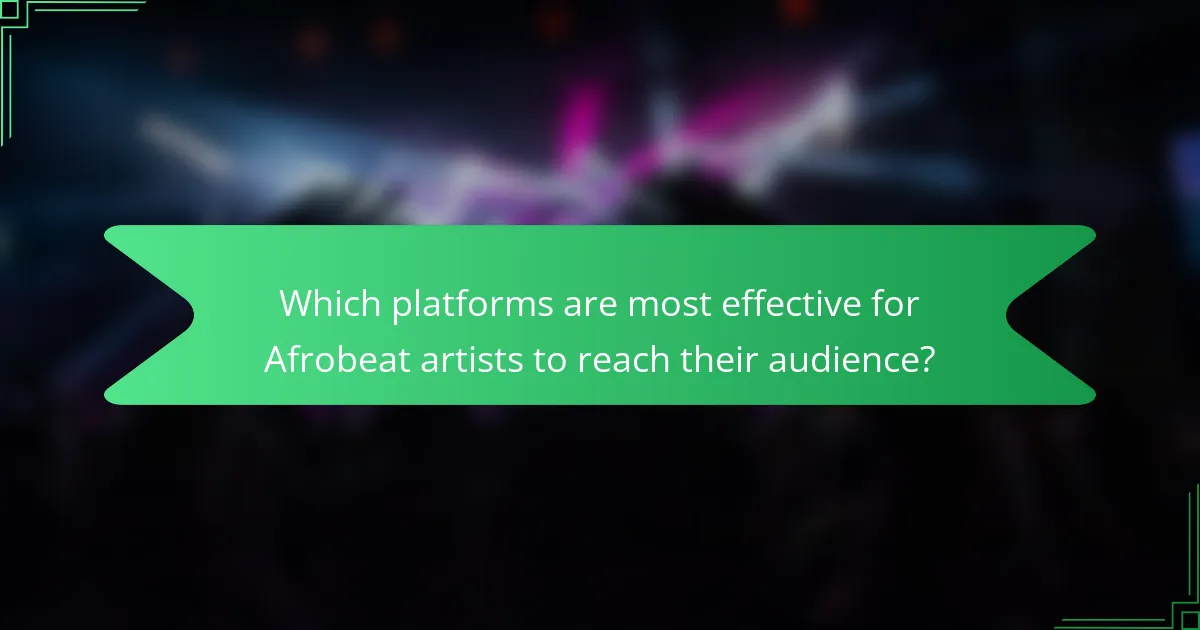
Which platforms are most effective for Afrobeat artists to reach their audience?
Social media platforms and streaming services are most effective for Afrobeat artists to reach their audience. Platforms like Instagram and TikTok allow for visual storytelling, while Spotify and Apple Music provide access to a global listener base.
Instagram enables artists to share engaging content, including dance challenges and behind-the-scenes footage, fostering community interaction. TikTok’s viral format can propel songs to widespread popularity, making it crucial for new releases.
Streaming services like Spotify offer curated playlists that feature Afrobeat, enhancing discoverability. Collaborating with influencers on these platforms can amplify reach and connect with diverse audiences.
Overall, a strategic mix of social media engagement and streaming presence is essential for Afrobeat artists to thrive in today’s music landscape.
How do streaming services influence the visibility of Afrobeat music?
Streaming services significantly enhance the visibility of Afrobeat music by providing global access to diverse audiences. These platforms enable Afrobeat artists to reach listeners far beyond traditional boundaries, increasing their fan base and exposure.
The algorithms used by streaming services promote Afrobeat tracks based on user preferences, allowing for organic discovery. For example, playlists featuring Afrobeat songs often include popular tracks that attract listeners from various genres, facilitating cross-genre collaboration.
Moreover, streaming services often invest in marketing campaigns that spotlight Afrobeat artists, further elevating their profiles. This increased visibility can lead to opportunities for live performances and collaborations, enhancing the overall growth of the genre.
In addition, data analytics from streaming platforms help artists understand their audience demographics, allowing for targeted marketing strategies. This insight enables Afrobeat artists to tailor their music and outreach efforts effectively, maximising their impact in the global music scene.
What role do social media and music festivals play in promoting Afrobeat artists?
Social media and music festivals significantly enhance the visibility of Afrobeat artists. They provide platforms for artists to showcase their work and connect with global audiences.
Social media enables direct engagement between artists and fans, fostering a community around Afrobeat music. Platforms like Instagram and TikTok amplify reach through viral content and user-generated challenges.
Music festivals, such as Afro Nation, create immersive experiences that celebrate Afrobeat culture. These events attract diverse audiences, allowing artists to perform live and gain exposure.
Together, these channels promote Afrobeat artists’ unique sounds, helping them cross cultural boundaries and build international careers.
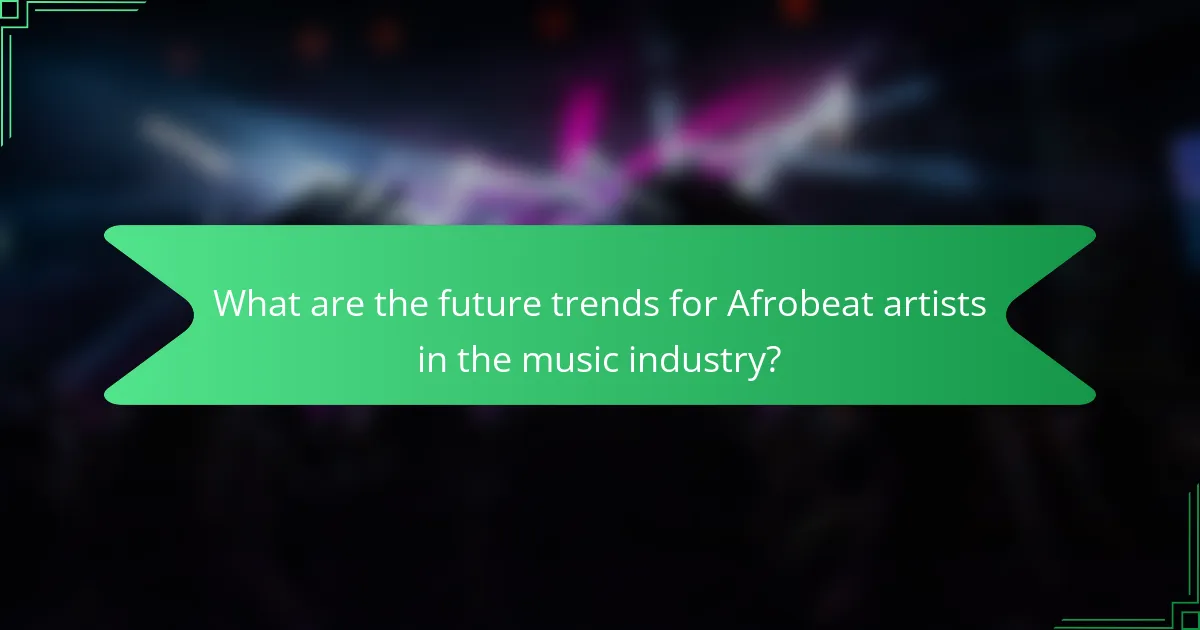
What are the future trends for Afrobeat artists in the music industry?
Afrobeat artists are increasingly integrating technology and global collaborations, shaping future trends in the music industry. The rise of digital platforms allows for broader distribution and audience engagement. Artists are experimenting with fusion genres, blending Afrobeat with hip-hop, R&B, and electronic music, enhancing their global appeal. Additionally, social media influences marketing strategies, enabling artists to connect directly with fans. As a result, Afrobeat is set to gain more prominence in mainstream music, reflecting its unique cultural roots and contemporary relevance.
How are technological advancements shaping the production of Afrobeat music?
Technological advancements are revolutionising Afrobeat music production by integrating digital tools and platforms. Artists utilise software for sound design, allowing for innovative blends of traditional African rhythms with modern genres. Digital distribution channels enhance global reach, enabling wider audience engagement. Additionally, collaboration tools facilitate remote partnerships, fostering diverse influences in Afrobeat. The unique attribute of live instrumentation is often preserved, while rare electronic elements are incorporated, creating a fresh soundscape.
What emerging artists are expected to influence the future of Afrobeat?
Emerging artists like Tems, Omah Lay, and Rema are expected to significantly influence the future of Afrobeat. These artists blend traditional African rhythms with contemporary genres, creating unique sounds that resonate globally. Tems, known for her soulful voice, has gained international acclaim, collaborating with major artists. Omah Lay combines Afrobeat with elements of R&B, showcasing a fresh perspective. Rema’s fusion of Afrobeat with pop and trap has also garnered a diverse audience. Their innovative approaches and global collaborations position them as key players in shaping the evolution of Afrobeat.
What best practices should aspiring Afrobeat artists follow to succeed?
Aspiring Afrobeat artists should focus on authenticity, collaboration, and audience engagement to succeed. Embrace traditional African rhythms while integrating modern genres for a unique sound.
1. Develop a unique sound: Blend traditional Afrobeat elements with contemporary styles to create a distinctive musical identity.
2. Collaborate with other artists: Partner with musicians from diverse backgrounds to expand your reach and creativity.
3. Utilise social media: Promote your music and connect with fans through platforms like Instagram, TikTok, and YouTube.
4. Perform live: Engage with audiences through live performances to build a loyal fan base and gain exposure.
5. Consistent content creation: Regularly release new music and updates to keep your audience engaged and interested.
6. Network within the industry: Attend events and connect with other professionals to build relationships that may lead to opportunities.
